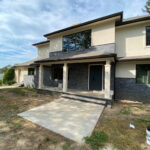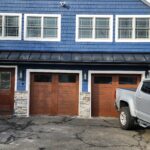Residential Siding
We are proud preferred providers of these well known brands of siding
Types of Siding Every Homeowner Should Consider
1. Vinyl Siding
Pros: Affordable & Lots of Variety
Cons: Not the most durable option

Vinyl siding is a fairly popular choice for homes for a few reasons. First, everyone is fairly familiar with vinyl siding. Because of this, it makes for a safe choice for homeowners because they are already knowledgeable about the product. In addition, it is also one of the most affordable types of siding, as it is an economic option. However, this does make it not as durable as some of the other siding options available. But, it does come with a wide range of colors, which is another reason people are drawn to it. Check out this siding buyers guide if you are looking for more info!
All in all, vinyl siding will get the job done, but it is more likely to succumb to damage by hail, baseballs, and other objects flying through the sky.
2. Insulated Vinyl Siding
Pros: Improved home insulation and durability, with the same variety of traditional vinyl.
Cons: Still not as durable as other siding options.

Next up, we have insulated vinyl. What makes this different from regular vinyl is that the insulation is built right into the ridge of the panel. Having the insulation set up this way helps to insulate the home better and overall help secure the temperature of homes — which can help save you money. It also helps make it more durable, meaning you may be spending less on repairs or replacement siding.
With insulated vinyl siding, you get an upgrade from regular vinyl while also maintaining a large number of color options as well
3. LP SmartSide
Pros: Highly durable & can be repainted.
Cons: More expensive than the average homeowner is looking to pay.

LP SmartSide is engineered hardwood that is extremely durable. In fact, it’s so durable that the manufacturing of this siding allows for a 50-year warranty. Also, the company that puts the finishing on it has a lifetime guarantee. In other words, the extra money you use to purchase this type of siding will be well worth it down the road. Even if you’re not planning on sticking around for 50 years, having LP SmartSide can help bring up your home’s value.
Unlike with vinyl, you can paint this type of siding so if you ever get sick of the color, want something new to update your home, or are looking to tackle a new color trend, this siding allows for just that. When it comes to which color you want, the sky is the limit. You can have any custom color on your home with LP SmartSide siding.
4. Hardie Board Siding
Pros: Highly durable & top-notch quality control.
Cons: More expensive than vinyl & shorter warranty than LP SmartSide
If you think siding that contains cement would be very durable, then you’d be right. Hardie Board siding is extremely strong and can handle all sorts of objects and elements thrown its way. Unlike LP SmartSide, James Hardie paints their siding in-house, so you know you’ll get that consistency across the board. They offer a 30-year warranty and you can once again get any custom color for your home.
5. Everlast Composite Siding
Pros: One of the most durable types of siding available, comes with a ‘length of ownership’ warranty.
Cons: Restricted color options & price.

Last, but certainly not least, we have Composite Everlast. Made from crushed rock with polymers and resins, you’d be hard-pressed to find a stronger, more sturdy siding. Everlast is so confident in this product, they offer a guarantee for as long as you own the home. While the colors are a little more limited, they do have a nice variety of slap options so you can find the perfect fit for your house. If composite siding is on the top of your list, check out this collection of the best composite siding options.
6. Natural Wood Siding
Pros: Easy to change the look with paint or stain. It’s easy to repair and is eco-friendly.
Cons: Expensive and high-maintenance.

While most other siding materials attempt to recreate and capture the true look of wood, only real wood shingles can have that undeniable aesthetic. Real wood shingles are still the choice of many homeowners, especially in the west. Its texture and curb appeal can’t be matched for many who choose not to go the synthetic route.
Installing real wood shingles can be a costly endeavor, but ultimately worth it in the end. With wood siding comes the benefits of being able to easily paint your house to change its look. You can also stain or re-stain for an added boost in curb appeal. There are a few downsides to wood siding, though, including a high up-front cost.
Natural wood siding also requires quite a bit of maintenance to keep it in good shape. Unless you have cedar shakes, consider re-painting or re-staining your wood shingles every 5-7 years depending on its condition. Also, rodents and bugs like termites can infiltrate your siding, so it’s important to watch for holes or signs of chewing on your shingles. Luckily, those repairs are quick and easy to take care of. It’s good for homeowners to regularly check for the integrity of their siding. Trapped water or moisture can lead to wood rot. In the case of rotten wood, it’s best to call your professional for a full tear down and replacement of that area.
7. Manufactured Wood Siding
Pros: Looks like the real thing, at a fraction of the cost.
Cons: Moisture is its sworn enemy — causing mold and mildew if moisture is trapped behind the siding.
Other wood sidings include cedar shakes, engineered wood, and board and batten. Cedar lasts up to 100 years and ages gracefully. It might be the most maintenance-free one of them all. Board and batten or slats can give your home’s exterior a beautiful aesthetic not often seen by using basic shingles. And engineered wood siding is just what it sounds like. It’s wood siding that has been manufactured to only look real, but is in fact made of a blend of materials. Manufactured wood siding is great because it is a mere fraction of the cost of real wood. Not to mention, it requires much less maintenance! Just make sure you keep moisture out from behind the siding as it can easily cause mold and mildew.
8. Metal Siding
Pros: Low maintenance, resistance to bugs and fire, and environmentally-friendly.
Cons: Potential for rust in wet or coastal climates. Lighter metals, like aluminum, can be prone to dents and damage.

Metal siding and roofing have both been on the rise and becoming more and more popular in residential homes. Despite its expensive cost upfront, the longevity and durability of metal siding make it worth it. Metal is great for homeowners looking for sustainable products because even if their siding is replaced, the used materials are completely recyclable. Other roofing materials end up in landfills for decades upon decades.
Metal siding is also resistant to bugs, mold, and fire. While metal siding is quite durable, it can be susceptible to rust (for steel siding) or dents (primarily for aluminum siding). The good news is, homeowners don’t need to worry about termites or any pesky rodents chewing through their steel siding. Plus, metal siding can be manufactured to imitate any other types of siding, but with that added benefit of durability and long life.
9. Fiber Cement Siding
Pros: Versatile design (can be painted over), durable, very long-lasting. Some manufacturers offer anywhere from a 30 to 50-year warranty on fiber cement siding!
Cons: More expensive than vinyl, high-maintenance, and low R-value.
Fiber cement siding is a high-quality material that can look and act like vinyl siding, cement siding, and wood siding — but with added durability. Fiber cement siding is manufactured to withstand the elements and keep your home safe and secure without sacrificing the look.
Vinyl siding and fiber cement both have a similar look with the wood “grain” look and come in a variety of colors and textures. However, you can probably expect the most you would pay for custom vinyl siding is likely the least you might pay for fiber cement. But, the genuine look you can get with fiber cement definitely gives you more of a return on investment to your home.
10. Brick
Pros: Beautiful, very low-maintenance, fire-resistant, and provides great temperature control.
Cons: Not a ton of options, may require re-mortaring at one point, and it’s more expensive than other materials.








